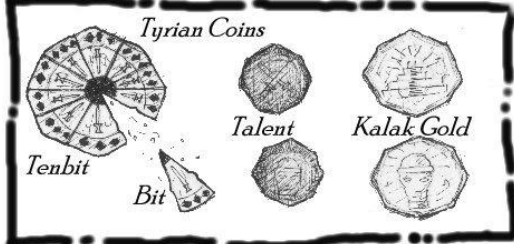
“Is it true? Kalak dead? Slaves freed? Magic wild in the streets? Doubtful, but we’ll know soon enough.”
- Shahin, wandering hermit
Population: 12,000 (70% human, 10% dwarf, 6% mul, 3% elf, 1% half-elf, 9% half-giant, 1% thri-kreen, a few halflings). Natives called “Tyrians.”
Emblems: Formerly Kalak’s profile; currently undecided.
Economy: Iron, silk; economy currently in collapse.
As far as most Athasians are concerned, Tyr has always existed. Certainly it has endured through the entire Desert Age, and even with the fall of its sorcerer-king, it seems likely to endure for centuries to come. And throughout all the long years of its existence, it was a city-state enslaved. That has all changed. In the courts of the other city-states, rumors of King Kalak’s overthrow are only whispered, but in Tyr, the repercussions howl through the streets. Many scheme to succeed Kalak, and the templars and other power groups vying for control struggle to keep the city-state from disintegrating into anarchy at the hands of people eager to enjoy their freedom. Nobles and merchants clamor for influence, and commoners and freed slaves openly celebrate, challenging civic authority and social boundaries at every turn. Tyr hunkers within high walls in the middle of the fertile Tyr Valley, which lies in the foothills of the Ringing Mountains. From miles away, a traveler can make out the massive spires of the Golden Tower rising over the citystate’s walls. Not far from the tower, a brick step-pyramid soars above the walls: the Ziggurat of Kalak, multicolored and resplendent under the desert sun. The city walls are parched sandstone, smoothed by time and centuries of continual repair. Beyond Tyr loom the ramparts of the Ringing Mountains, whose topmost peaks glint with a dusting of snow during the months of Sun Descending. Most traffic enters the city-state through the eastern Caravan Gate. This structure consists of two marble valves, each 20 feet high and nearly as wide, which are banded and hinged in precious iron. Inside, the thoroughfare known as Caravan Way leads through the Caravan District toward the heart of the city, where the Merchant District is nestled at the base of the towering Ziggurat of Kalak. The spacious stone residences that make up the twin wards of the Noble District lie north and south of the Caravan District, easily differentiated from the press of adobe buildings in the surrounding neighborhoods. Commoners and freed slaves live cheek by jowl in the Warrens, a medley of unplanned structures that sprawls away north of the Ziggurat.
Criminal gangs roam the Warrens, preying on the weak. Temporary shelters built by recently freed slaves have sprung up in the Artisan District on the ziggurat’s north side. Although shelter and access to water is less certain in the Artisan District, fewer bodies turn up here each morning than in the Warrens. This district also now doubles as a training area for gladiators who choose to fight in the Stadium of Tyr during the infrequent games held there. The stadium separates the Ziggurat of Kalak from the Golden Tower. Under the new regime, the sound of spectators screaming for their favorites is heard on just ten days of every month. The rest of the time, the stadium serves as an overflow market of disorganized stalls, tents, and blankets where misfit traders offer a multitude of goods and services. Tyr has always been two cities in one: the greater city, which is composed of commoners, slaves (now freed), and nobles, and the smaller Golden City, which is dominated by the Golden Tower and is the home of the resplendent King’s Gardens.
Many civic structures surround the tower,
along with giant warehouses that hold precious reserves
of grain, iron ingots, water, and weaponry. In addition,
the Golden City houses upper-class functionaries and
templars.
The Golden Tower, Tyr’s most majestic piece of
architecture, is constructed of rare golden granite and
contains dozens of chambers linked by winding passages.
A separate observation spire stands nearby, a smaller
version of the main tower; a soaring bridge connects the
two structures. According to rumor, defiling magic binds
ancient elementals to the Golden Tower, creatures that
remain vigilant against potential attackers. Since King
Kalak fell, all attempts at entering the tower have failed.
Finally, beneath the city lies Under-Tyr, catacombs that
represent the leavings of more than two thousand years
of urban construction on the same site. Buried streets,
cracked courtyards, and crumbling ruins abound in the darkness beneath Tyr. Secret cellars in surface buildings
offer access into this dangerous realm of subterranean
passages and forgotten neighborhoods.
Roughly 15,000 reside within the city walls, and about
as many in the noble estates and villages of the Tyr
Valley. Humans are the majority, constituting two-thirds
of the population while dwarves, elves, half giants, and
muls make up most of the rest.
